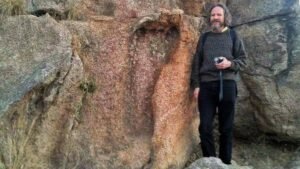South Africa’s Hidden Giant: 200-Million-Year-Old Footprint Discovered—The Evidence Is Stunning
South African author and explorer Michael Tellinger, often called “The South African Indiana Jones,” has shared what could be a major discovery about ancient giants.
In Mpaluzi, near the Swaziland border, Tellinger found a huge footprint that some believe might prove giants once walked the Earth. Professor Pieter Wagener from Nelson Mandela Metropolitan University, who has a PhD in applied maths, says it’s more likely this footprint wasn’t made by natural erosion. He jokingly suggests it’s more believable that little green aliens could have made it.
This massive footprint is thought to be between 200 million and 3 billion years old, based on how granite forms over time.

This dating has sparked a lot of debate, so it’s important to keep an open mind and focus on the evidence.
The footprint was found in a remote area of South Africa called Eastern Transvaal, which was once home to animals like antelope and lions. This spot is still as isolated as it was when the footprint was discovered, making it unlikely to be a hoax.
The real puzzle is how this footprint came to be. No one is sure, but it’s there, and we can’t ignore it.
Though it’s made of granite, which is a common geological feature in South Africa and shown on maps, the footprint remains a mystery.

Robert Schoch stands near the mysterious granite impression that some believe to be a giant footprint.
The granite in question is described as “phenocrystic” or coarse porphyritic granite, known for its large and small grains resulting from various cooling phases. This unique texture makes it highly desirable for granite merchants who want to mine and polish it for its striking appearance.
This outcrop is called the Mpuluzi Batholith in South African geology. Official tests have dated the rock to around 3.1 billion years old.
“This is a real puzzle that needs thorough scientific study,” says Schoch.
In 1520, Ferdinand Magellan made an unusual stop in what is now Patagonia. There, he encountered a giant, naked figure dancing and singing on the shore. Magellan, ever the diplomat, sent one of his crew to interact with the giant. The crew member’s reaction to this bizarre encounter is lost to history, but Magellan had instructed him to join in the dancing and singing to show friendliness.
The plan worked. The crew member led the giant to a small offshore island where Magellan was waiting. Antonio Pigafetta, a scholar and diarist who accompanied Magellan, described the scene in his book *Magellan’s Voyage: A Narrative Account of the First Circumnavigation*: “When the giant saw us, he was both amazed and frightened. He raised a finger as if to say we came from the heavens. He was so tall that even the tallest of us only reached his waist, and his voice was thunderous.”
This account, while not definitive proof, suggests that Magellan may have encountered the Tehuelche people, who were indeed very tall. It’s possible that these giants were the source of the myth. Magellan’s attempt to bring back evidence of these giants was, admittedly, rather intrusive.
